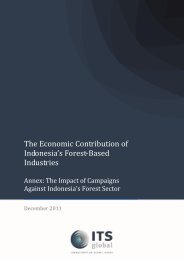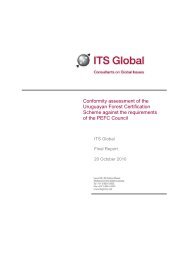Forest Certification â Sustainability, Governance and Risk - ITS Global
Forest Certification â Sustainability, Governance and Risk - ITS Global
Forest Certification â Sustainability, Governance and Risk - ITS Global
You also want an ePaper? Increase the reach of your titles
YUMPU automatically turns print PDFs into web optimized ePapers that Google loves.
<strong>Forest</strong> <strong>Certification</strong> – <strong>Sustainability</strong>, <strong>Governance</strong> <strong>and</strong> <strong>Risk</strong> January 2011<br />
Notably FSC cannot gain membership to the IAF. The IAF requires that services provided by<br />
one IAF accreditation body member must be accessible to other IAF members. To gain<br />
membership, FSC would have to relinquish its monopoly on accrediting FSC certification<br />
bodies.<br />
But there are few indications that FSC is willing to introduce greater impartiality into its<br />
processes. FSC proudly promotes an ―integrated‖ rather than an ―arms-length‖ system:<br />
“FSC is the only global forest management certification system with an integrated<br />
accreditation program that systematically controls its certification bodies.‖ 37<br />
To add credibility to its st<strong>and</strong>ard setting procedure, FSC associated itself with another<br />
international body – International Social <strong>and</strong> Environmental Accreditation <strong>and</strong> Labelling (ISEAL)<br />
Alliance. 38 FSC helped developed <strong>and</strong> subscribed to ISEAL‘s Code of Good Practice for Setting<br />
Social <strong>and</strong> Environmental St<strong>and</strong>ards. The Code states that compliance will ensure ―the process<br />
by which a st<strong>and</strong>ard [is developed] is credible.‖ However the code does not require arms-length<br />
separation between st<strong>and</strong>ard setting <strong>and</strong> accreditation.<br />
ISEAL provides FSC with ‗reputable‘ accreditation. In fact it gives authority to FSC to control<br />
<strong>and</strong> influence the entire st<strong>and</strong>ards <strong>and</strong> conformance process without the checks <strong>and</strong> balances<br />
required under ISO/IAF guidelines. In this way FSC is able to control the core elements of policy<br />
by effectively operating both the functions of st<strong>and</strong>ard setting <strong>and</strong> conformity assessment<br />
(including accreditation <strong>and</strong> certification).<br />
4.4 Summary of Differences 39<br />
St<strong>and</strong>ard setting<br />
PEFC requires national st<strong>and</strong>ards for forest management <strong>and</strong> chain of custody to be set by<br />
National St<strong>and</strong>ards Bodies with technical committees <strong>and</strong> stakeholder consultation. The<br />
process follows ISO rules, including participation of stakeholders, public consultation, decision<br />
making by consensus <strong>and</strong> transparency. Before a national st<strong>and</strong>ard is adopted, it must also<br />
undergo an external conformity assessment to ensure that it meets the requirements of PEFC‘s<br />
international st<strong>and</strong>ard.<br />
FSC system requires that the st<strong>and</strong>ard be set internally, without complying with ISO guidelines<br />
<strong>and</strong> international best practice. FSC stakeholder participation requirements are weak 40<br />
decisions are not necessarily made by consensus, 41 <strong>and</strong> there is low transparency with no<br />
requirements for external review or assessment throughout the st<strong>and</strong>ard setting process (see<br />
Annex II). Furthermore FSC undermine their st<strong>and</strong>ard setting processes by allowing certification<br />
against interim st<strong>and</strong>ards. 42<br />
FSC st<strong>and</strong>ard setting processes do not meet international best practice<br />
<strong>Certification</strong> <strong>and</strong> accreditation<br />
<strong>Certification</strong> of compliance with a forest management st<strong>and</strong>ard is undertaken by third parties for<br />
both PEFC <strong>and</strong> FSC. However, PEFC requires third party certification bodies to be verified<br />
37<br />
FSC website, FSC Accreditation Program, accessed at: http://www.fsc.org/accreditation.html<br />
38<br />
FSC <strong>and</strong> other ecolabelling schemes such as the Marine Stewardship Council (MSC) <strong>and</strong> the Fairtrade Labelling<br />
Organisation (FLO) established the ISEAL Alliance as an authoritative accreditation framework.<br />
39<br />
For a detailed comparison of st<strong>and</strong>ard stetting processes, see Annex II<br />
40<br />
For instance only FSC members are allowed to join a Working Group (for st<strong>and</strong>ard development) <strong>and</strong> only members<br />
are formally invited to join the Consultative Forum - a body responsible for stakeholder participation in FSC st<strong>and</strong>ard<br />
setting - through an invitation in a FSC newsletter. The forum does not exclude participation of non-FSC members in the<br />
Consultative Forum; however there is nonetheless a bias in the process towards FSC members.<br />
41<br />
In some situations (for example approval of international st<strong>and</strong>ards) where consensus cannot be reached, decisions<br />
are made by majority vote. The document, FSC Procedure – the Development <strong>and</strong> Approval of FSC Social <strong>and</strong><br />
Environmental International St<strong>and</strong>ards (2006), states that ―if a vote is required, then consensus is defined as meaning<br />
that at least 66% of the members of the Working Group vote in favor of the proposal, <strong>and</strong> there are no votes against the<br />
proposal‖.<br />
42<br />
St<strong>and</strong>ards that are yet to complete the entire st<strong>and</strong>ard setting process<br />
Page 18 of 42




